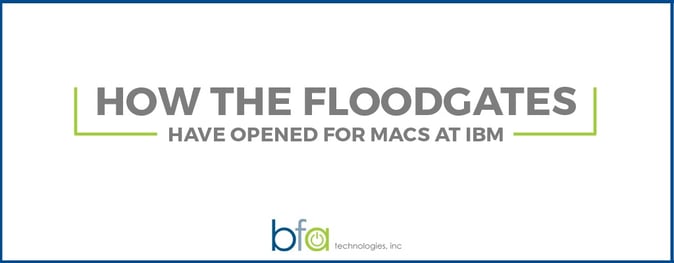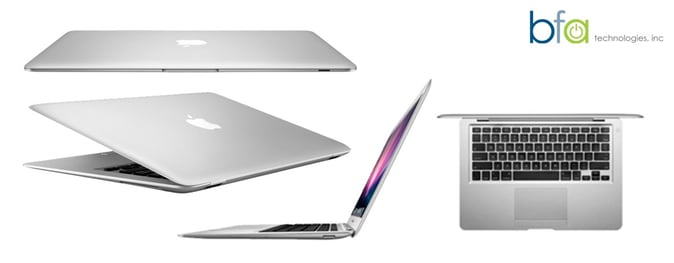
When you consider how swiftly it occurred, The opening of the floodgates to allow Macintosh computers into the hands of IBM employees might be considered a bit revolutionary. <Click to Tweet>
At the beginning of 2014, it is believed that approximately 4% of IBM employees used Apple Macintosh; and nearly all of these were on a bring-your-own-device or BYOD basis. Since that time, IBM has disclosed their plans to perhaps order up to a stunning 200,000 Macs a year. If achieved, this number would approximately represent an incredible 75% of the total number of personal computers for all of IBM’s employees.
How did this potential come about? Why such a sudden, monumental change in the IBM workplace? To better understand, we need to take a look behind the scenes of the recent Apple and IBM partnership.
Apple and IBM through the years
The rivalry between Apple Inc. and IBM Corp. was decades long before their partnership in July of 2014. They were both involved in the heated personal computer race in the early ‘80s when IBM created a personal computer alternative to Apple’s offerings. In 1981, once Apple welcomed IBM to the game, the race was on.
But as PCMag states, there were still several periods during those years in which the companies actually joined forces on various projects. These joint solutions enjoyed relative degrees of success; but the two companies nonetheless remained bitter rivals throughout the years.
Then in 2005, IBM decided to exit this market by selling its PC business to Lenova for $2.3B. In some respects, this served as the beginning of the “softening” of this long-time rivalry. But nothing has ever come close to the symbiotic relationship between those two “giants” that we see today through recent announcements.
“The” partnership
In 2014, the two tech giants made public their plans for IBM to develop made-for-business mobile applications that would leverage IBM’s data analytics and cloud services and run on the Apple iPad mobile platform.
IBM has long been a bellwether in the arena of enterprise IT support and services. But without a mobile platform of its own, IBM was seeking a way to ride the wave of the new “mobile first” economy, thereby entrenching itself even further into the enterprise.
On the other hand, despite its monumental rise to the top as the largest technology company in the world, Apple significantly lacked a strong and influential sales and support presence in the enterprise. In addition, Apple had seen sales of its iPad mobile tablet diminish quarter over quarter for quite some time. And so, as a result of these two scenarios, the creation of a joint partnership simply made sense:
• IBM would create enterprise-ready, vertical mobile business apps to leverage Apple’s iPad platform, thereby giving IBM the platform and the vehicle it needed to offer solutions to address enterprise clients’ mobile needs.
• In turn, Apple would be able to leverage IBM’s large enterprise sales and support infrastructure to help further the penetration of Apple products into the enterprise.
But it didn’t end at mobile devices.
The floodgates open for Macintosh computers at IBM

Initially unknown to the public, Apple had included an interesting stipulation as a part of its joint agreement with IBM:
When promoting and presenting their mobile solutions to enterprise clients, IBM salespeople must use Apple’s Keynote presentation application running on an Apple Macintosh computer.
On the surface, this requirement makes sense for Apple as it’s fair to say that it would be somewhat awkward for clients to witness IBM salespeople promoting Apple iPad-based apps using, for example, Microsoft Powerpoint software running on a Dell or HP Windows-based personal computer. This therefore brought about the obvious need for IBM to purchase a fair number of Apple Macintosh computers for use by its mobile sales force.
But then, a very interesting byproduct came about as a result of this requirement. With the influx of these new Apple devices, IBM quickly began to realize the many benefits and full value proposition of Apple Macintosh for its employees.
Consequently, IBM subsequently announced that - for the first time in its history - IBM employees would be allowed to choose Apple Macintosh (as an alternative to Lenovo Thinkpads) as their corporate issued personal computer of choice. As it turns out, there were already an approximate 15,000 bring-your-own-device (BYOD) Apple Macs in IBM despite the fact that it had never really been an officially accepted corporate platform. But as a result of this new corporate policy, Macs would now be officially offered and supported - instead of simply tolerated - by the company.
Originally, IBM estimated that it would purchase around 50,000 additional employee Macs by the end of calendar 2015. But this stunning figure - and the possibility of greatly increasing it - brought about direct discussions between the CTO’s of the two respective companies.
As a result of these discussions and subsequent negotiations, it was the disclosed that IBM might potentially purchase 150,000 to 200,000 employee Apple Macintosh computers a year. This number would represent not only roughly 75% of all personal computers for IBM employees, but at the same time, it would also place IBM atop the list of all Apple clients with regard to the annual volume purchase of Apple Macintosh.
So why the drastic shift in favor of Macs at IBM? There are some key and substantial advantages of Apple Macintosh as Puga Sankara of EBN explains in five points. To paraphrase:
1) Macintosh computers keep employees as productive as possible and provide a great employee experience
2) They help in attracting the best talent
3) They are arguably the favorite choice of millennials.
4) They cast companies in a forward-facing and innovative light
5) They help companies stay ahead of the competition
The future

Though IBM employees are not required to choose Apple MacBook laptops as their IBM-provided personal computer, they now have the option to do so whereas, previously, they would have been mostly relegated to purchasing the MacBooks themselves.
Many IBM employees have already expressed their excitement regarding this new IBM policy since Macs were already their platform of choice for consumer use. So now, IBM employees’ love of Macintosh and its many benefits at home will be able to be extended and enjoyed into their work environments as well.
All in all, for IBM, it appears that there are many great things on the horizon for both the company as well as its employees as both a direct and indirect result of IBM’s new relationship with Apple. And it will be interesting to see both the near-term as well as the long lasting effects of this potential tidal wave of Apple Macintosh into IBM.
If you’d like to learn more about the advantages of deploying Apple Macintosh in your organization, BFA Technologies, Inc. would like to help. Simply contact us to learn more about our Windows-to-Mac migration consulting and support services.
Tags:
Wed,Sep 09, 2015 @ 09:00 AM
Comments